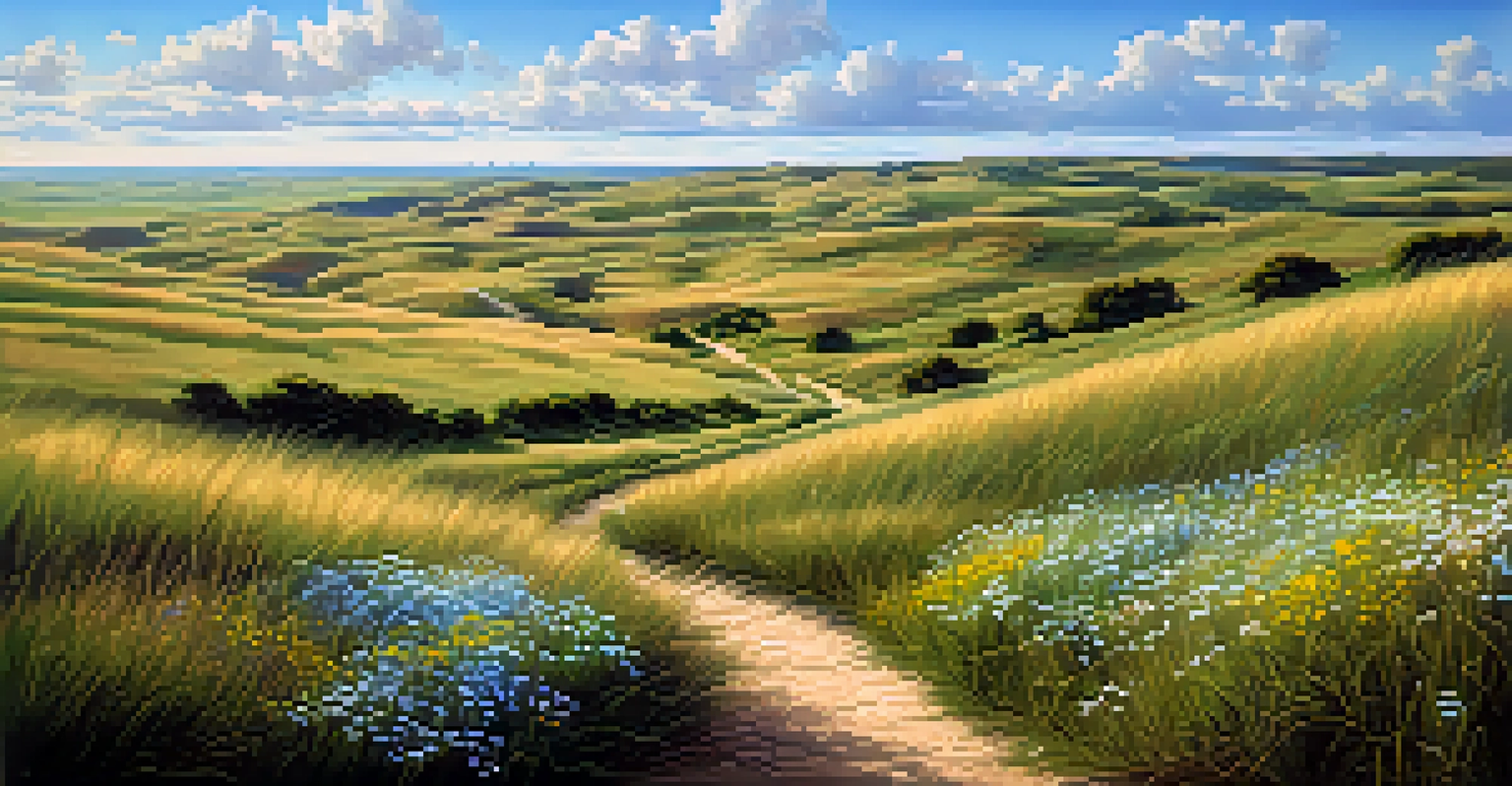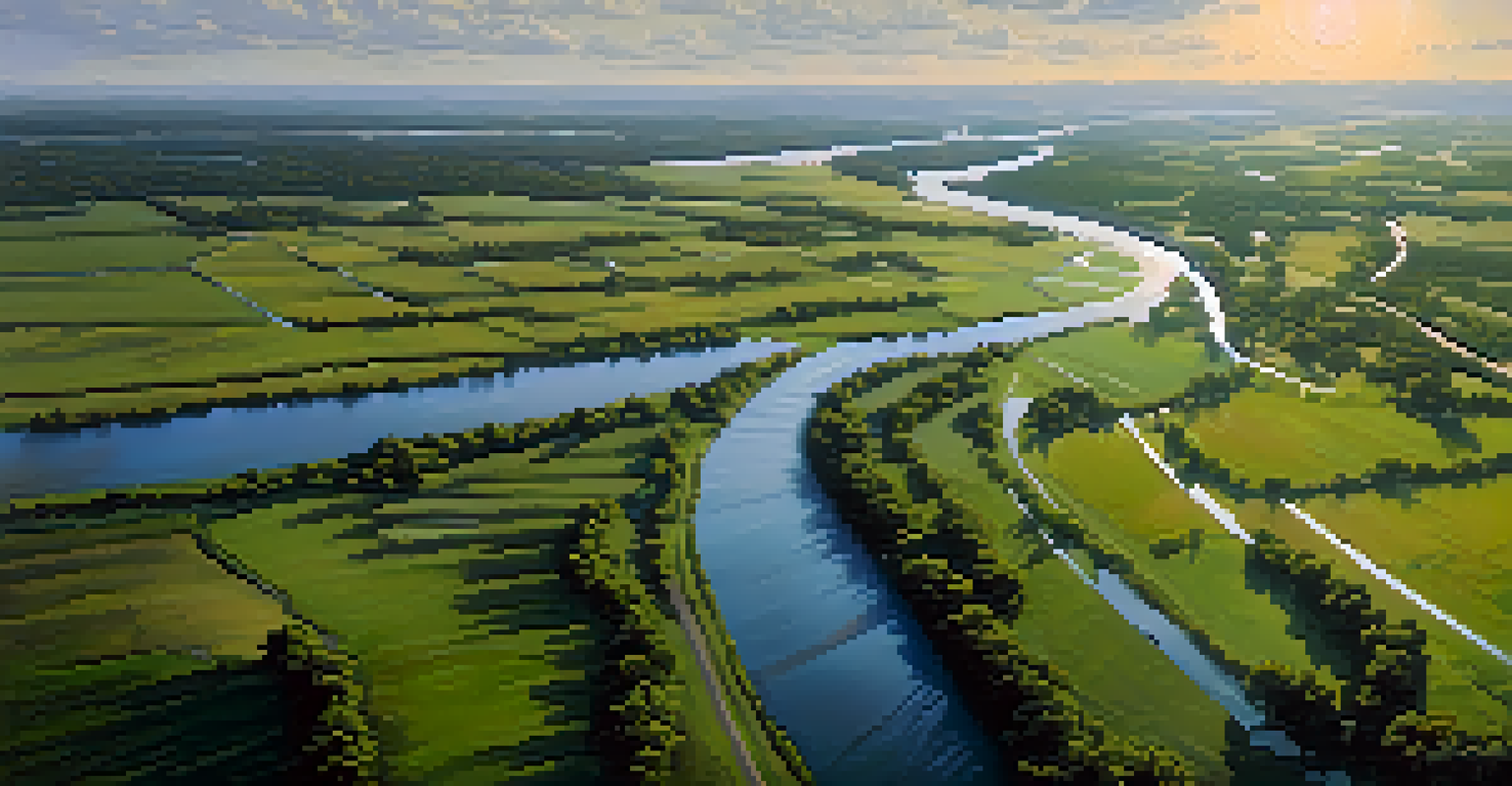Geographical Features of Kansas: Plains, Hills, and Rivers

The Expansive Great Plains: Kansas' Heartland
Kansas is predominantly known for its vast Great Plains, a region that stretches across the state. These plains are characterized by their flat, open landscapes, which create an iconic view of endless skies and golden wheat fields. Farmers and ranchers thrive in this area, cultivating crops and raising livestock, contributing significantly to the state's economy.
The land is the basis of all wealth, and its value has increased with every advance in civilization.
The Great Plains are not just a sight to behold; they also play a crucial role in sustaining local ecosystems. Grasses dominate the region, providing habitat for various wildlife species, from deer to prairie chickens. This unique blend of agriculture and nature showcases the balance Kansas maintains between development and preservation.
Moreover, the Great Plains offer recreational opportunities for residents and visitors alike. Hiking, birdwatching, and photography are just a few activities that allow people to connect with the serene beauty of the plains. Whether you're a local or a tourist, these expansive landscapes certainly leave a lasting impression.
Rolling Hills: The Flint Hills Region
Contrasting sharply with the flat plains, the Flint Hills region introduces a series of rolling hills, showcasing a different side of Kansas' geography. This area is renowned for its tallgrass prairies, which are some of the last remaining in North America. The undulating hills create picturesque vistas that are perfect for exploring the state's natural beauty.

The Flint Hills are not only visually striking but also ecologically significant. They support a rich diversity of plant and animal life, with unique species that thrive in the tallgrass ecosystems. This region is a testament to the importance of maintaining natural landscapes, as it serves as a refuge for many species.
Kansas' Diverse Geographical Features
Kansas showcases a variety of landscapes, from the expansive Great Plains to the rugged Smoky Hills and unique Sand Hills.
Additionally, the Flint Hills are home to the picturesque Tallgrass Prairie National Preserve, where visitors can hike, camp, and learn about the area's ecology. The rolling hills provide a sense of adventure and exploration, inviting individuals to immerse themselves in the beauty of Kansas' natural environment.
Rivers of Kansas: Lifeblood of the Land
Rivers in Kansas, such as the Kansas River and the Arkansas River, are vital to the state's geography and culture. They not only provide water resources but also create fertile valleys that support agriculture and biodiversity. The rivers serve as essential channels for transportation and recreation, contributing to both the economy and quality of life.
In every walk with nature, one receives far more than he seeks.
The Kansas River, particularly, meanders through the heart of the state, offering stunning views and abundant wildlife along its banks. Kayaking, fishing, and hiking along the river trails allow residents and visitors to experience the outdoors while enjoying the serenity of flowing water. These activities foster a connection to nature that is cherished by many.
Moreover, the rivers play a significant role in the history of Kansas, serving as routes for exploration and settlement. They have shaped the landscape and the lives of those who call Kansas home. Understanding the rivers' importance helps us appreciate the interconnectedness of geography, history, and culture in this vibrant state.
The Smoky Hills: A Hidden Gem
Nestled in north-central Kansas, the Smoky Hills present a unique geographical feature that often goes unnoticed. These hills are characterized by their rugged terrain and rocky outcrops, offering a stark contrast to the surrounding plains. This region is not only beautiful but also rich in history, with Native American and pioneer stories woven into its landscape.
The Smoky Hills are also known for their distinctive geology, which includes limestone and sandstone formations. These rocky structures create fascinating hiking trails and scenic overlooks that draw outdoor enthusiasts. Exploring this area reveals the hidden beauty of Kansas and provides opportunities for adventure and discovery.
Vital Role of Rivers in Kansas
The Kansas and Arkansas Rivers are crucial for agriculture, recreation, and historical significance, shaping both the economy and culture of the state.
In addition, the Smoky Hills are home to various wildlife species, making it a great spot for birdwatching and nature observation. The diversity of habitats in this region contributes to the overall ecological richness of Kansas. For those seeking a different experience away from the flatter areas, the Smoky Hills are a must-visit destination.
Importance of the Arkansas River
The Arkansas River is one of the most significant rivers in Kansas, flowing through the southern part of the state. This river has been crucial for agriculture, providing irrigation that supports farming in the surrounding regions. It also serves as a crucial resource for communities, supplying water for drinking and recreation.
Along its banks, you'll find vibrant ecosystems that support diverse wildlife, making it a great spot for fishing and birdwatching. The river's winding path creates opportunities for scenic hikes and outdoor activities, allowing people to engage with nature while enjoying the beauty of Kansas. The Arkansas River truly enhances the state's landscape and lifestyle.
Additionally, the river has historical significance, serving as a vital transportation route during the westward expansion. Understanding the Arkansas River's role in shaping Kansas helps us appreciate the state's rich history and the importance of its natural resources. It's a reminder of how water has always been a lifeline for communities.
The Role of Wetlands in Kansas
Wetlands in Kansas, although often overlooked, play a vital role in the state's ecology. These areas, which include marshes and swamps, provide essential habitats for numerous species of birds, fish, and other wildlife. They also serve as natural water filters, improving water quality and preventing flooding by absorbing excess rainwater.
Wetlands are hotspots of biodiversity and offer unique opportunities for research and education. They attract birdwatchers and nature lovers, who come to witness the seasonal migrations and enjoy the tranquil environment. These areas remind us of the importance of preserving natural spaces for future generations.
Importance of Wetlands in Ecology
Wetlands in Kansas are essential for biodiversity, water quality, and flood prevention, highlighting the need for their preservation.
In Kansas, initiatives are in place to protect and restore wetlands, ensuring that they continue to thrive. By understanding the role of wetlands in the ecosystem, we can advocate for their preservation and recognize their value in maintaining the health of our environment. Kansas' wetlands are truly a treasure worth exploring.
The Sand Hills: Unique Geography of Western Kansas
The Sand Hills of western Kansas present another intriguing geographical feature, characterized by rolling sand dunes that create a unique landscape. These hills were formed by ancient wind-blown sands, resulting in a distinct ecosystem that supports various plants and wildlife adapted to sandy conditions. This area is a prime example of how geography shapes both the environment and the life it sustains.
The Sand Hills offer a range of recreational activities, including hiking, horseback riding, and photography. The unique terrain attracts outdoor enthusiasts looking for adventure in a less-traveled part of the state. With their gentle slopes and wide-open spaces, the Sand Hills provide a perfect backdrop for exploration and relaxation.

Moreover, the Sand Hills play a crucial role in the local culture, influencing the lifestyles and traditions of the communities that inhabit the area. Understanding the significance of these hills helps highlight the diverse geographical features that contribute to Kansas' identity. The Sand Hills are a reminder of the beauty and variety that lie within the Sunflower State.